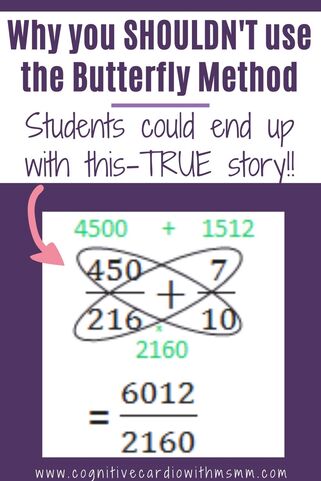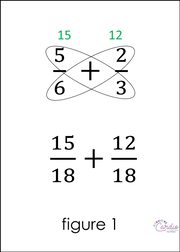How To Do The Butterfly Method
Why You lot Shouldn't Use the Butterfly Method

The "butterfly method" for comparing, adding, and subtracting fractions – WHY teach this? This is a serious question….why is this being taught?
I don't understand why the "butterfly method" is being used….
I empathise that it works and that it can make finding an answer easier for students (forsimplefractions). However, I've found definite drawbacks to this method, so I don't like to meet students calculation and subtracting fractions this manner!
Let me explicate what I've seen in sixth grade math:
Butterfly Method for Comparing Fractions
In past years, students would come up to sixth grade, having learned the butterfly method for comparing fractions…..
- they oft had no thought why it worked
- they knew the trick better than they knew how to detect a common denominator
- they didn't seem to understand that the products from the cantankerous-multiplying were theactual numerators they would go if they made certain equivalent fractions (shown in figure i beneath)
They but knew it worked.
This bothered me, because I believe they should empathizewhythings piece of work. And so I always made sure to explain why the method worked.
Butterfly Method for Calculation and Subtracting Fractions

Simply this twelvemonth, I had 6th grade math students tell me they were taught to employ the butterfly method to add and decrease fractions (cross multiply and add those products, so multiply the denominators together – shown in figure 2).
Simply once again, they didn't really have aconceptual
agreement of WHY it works.
It seems that many students are being taught "tricks" like this, to brand learning fraction operations "easier and fun."
In reality, students aren't learning what it means to add or subtract fractions. (And, actually, whywouldn'twe want them to see that half-dozen is the LCD in the problem in figure two? Why would we want to them to employ a larger denominator and so have to exercise more simplifying to everyman terms??)
| | |
Using the Butterfly Method on Larger Fractions:

I recently gave students trouble solving that required them to utilize all fraction operations. Since adding and subtracting is in the 5th grade math curriculum (and I teach sixth), I did just a brief review of calculation and subtracting fractions before students worked on these issues – to meet what they remembered.
This is when I institute out that many of them had been taught the butterfly method, among others.
In the problem solving, students had to add v/6, ii/iii, seven/12, and 7/10.
And here's where the butterfly method totally fails the students who have learned to rely on information technology , not only because they don't understand why it works, simply also because it becomes so cumbersome!
They couldn't use the butterfly method to add 3 or 4 fractions at a time, so they added two fractions at a time. Instead of finding a common denominator for all 4 fractions, they constitute a new common denominator each time they added on the adjacent fraction (and those denominators sure weren't the LCDs!).
- For example, they added 5/six and ii/3, getting a denominator of 18, equally in figure 2.
- So they added 27/18 and 7/12, equally in figure 3, getting a denominator of 216.
- From there, they added 450/216 and 7/10, shown in figure iv. They concluded upwardly with a HUGE denominator that they then had to work really hard to simplify!
It might seem surprising that they continued this process to get such huge numbers, but some of them did, because this was the method they learned and depended on. I was so shocked to run into this….and this is the first year I saw this method used in this mode.
Do Math "Tricks" Really Help?
When we as teachers (or parents) notice sure tricks that piece of work for simple math issues, we demand to expect ahead to what our students will experience in future years.
We demand to try these methods with more complicated bug, to come across if they will still be effective.
Nosotros need to think about whether the "tricks" teach them math concepts, or number sense, or number connections….or do they simply teach brusque-cuts?
I have no trouble with educational activity short-cuts in one case the conceptual understanding is at that place. Merely short-cuts before understanding is detrimental to our students. They are capable of understanding the concepts and we demand to have organized religion that they tin can "get information technology" without the tricks.
Thank you for reading! What are your thoughts or experiences with the "butterfly method"?
| | Need some materials to supplement your fraction instruction? Grab this free fraction toolkit when you join my email community! |
Source: https://cognitivecardiomath.com/cognitive-cardio-blog/why-not-the-butterfly-method-when-adding-and-subtracting-fractions/



0 Response to "How To Do The Butterfly Method"
Post a Comment